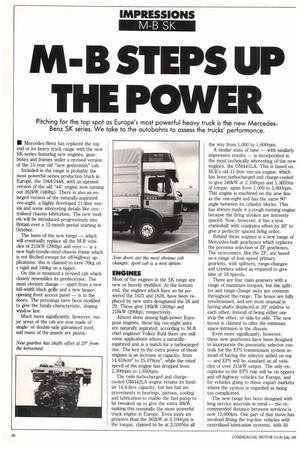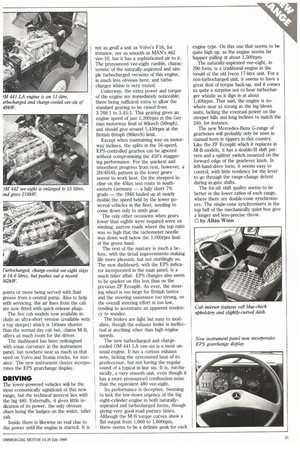M B STEPS UP THE POWER
Page 26

Page 27

If you've noticed an error in this article please click here to report it so we can fix it.
• Mercedes-Benz has replaced the top end ot its heavy truck range with the new SK-series featuring new engines, gearboxes and frames under a revised version of the 15-year old "new generation" cab.
Included in the range is probably the most powerful series production truck in Europe, the 1948/2448, with an upratal version of the old "44" engine now turning out 362kW (480hp). There is also an enlarged version of the naturally-aspirated vee-eight, a highly developed 11-litre veesix and some interesting details like centralised chassis lubrication. The new models will be introduced progressively into Britain over a 12-month period starting in October.
The basis of the new range — which will eventually replace all the M-B vehicles of 215kW (290hp) and over — is a new high-tensile-steel chassis frame which is not flitched except for off-highway applications: this is claimed to save 70kg on a rigid and 160kg on a tipper.
On this is mounted a revised cab which closely resembles its predecessor. The most obvious change — apart from a new full-width black grille and a new largeropening front access panel — is to the doors. The pressings have been modified to give the family-characteristic, sloping window line.
Much more significantly, however, major areas of the cab are now made of singleor double-side galvanised steel, and many of the panels are plastic.
ENGINES
Most of the engines in the SK range are new or heavily modified. At the bottom end, the engines which have so far powered the 1625 and 1628, have been replaced by new units designated the 26 and 29. These give 195kW (260hp) and 218kW (290hp), respectively.
Almost alone among high-power European engines, these big vee-eight units are naturally aspirated: according to M-B chief engineer Volker Rubl there are still some applications where a naturallyaspirated unit is a match for a turbocarged one. The key to the extra power of these engines is an increase in capacity, from 14,618cm3 to 15,078cm3, while the rated speed of the engine has dropped from 2,300rpm to 1,850rpm.
The twin-turbocharged and chargecooled 0M442LA engine retains its familiar 14.6-litre capacity, but has had improvements in bearings, pistons, cooling and lubrication to enable the fuel pump to be tweaked up to give the extra 30kW, making this nominally the most powerful truck engine in Europe. Even more impressive than the 362kW at 2,100rpm is the torque, claimed to be at 2,020Nm all the way from 1,000 to 1,600rpm.
A similar state of tune — with similarly impressive results — is incorporated in the most technically interesting of the new engines, the 0M441LA. This is based on M-B's old 11-litre vee-six engine, which has been turbocharged and charge-cooled to give 249kW at 2,100rpm and 1,365Nm of torque, again from 1,000 to 1,600rpm. This engine is machined on the ame line as the vee-eight and has the same 900 angle between its cylinder blocks. This has always made it a rough-running engine because the firing strokes are unevenly spaced. Now, however, it has a new crankshaft with crankpins offset by 30° to give a perfectly spaced firing order.
Behind these engines is a new range of Mercedes-built gearboxes which replaces the previous selection of ZF gearboxes. The newcomers, like the ZF, are based on a range of four-speed primary gearsets, with splitters, range-changes and crawlers added as required to give nine or 16 speeds.
There are four main gearsets with a range of maximum torques, but the splitter and range-change units are common throughout the range. The boxes are fully synchronised, and are most unusual in having shafts displaced at 20° relative to each other, instead of being either one atop the other, or side-by-side. The new layout is claimed to offer the minimum space intrusion in the chassis.
Even more significantly, however, these new gearboxes have been designed to incorporate the pneumatic selector controls for the EPS transmission system instead of having the selector added on top — and EPS will be standard on all vehicles of over 215kW output. The only exceptions to the EPS rule will be on tippers and off-highway vehicles for Europe, and for vehicles going to those export markets where the system is regarded as being too complicated.
The new range has been designed with long service intervals in mind — the recommended distance between services is now 12,000km. One part of that move has involved fitting the top-line vehicles with centralised lubrication systems, with 50 points or more being served with fluid grease from a central pump. Also to help with servicing, the air lines from the cab are now fitted with quick-release plugs.
The five cab models now available include an ultra-short version (available with a top sleeper) which is 140mm shorter than the normal day cab but, claims M-B, offers as much room for the driver.
The dashboard has been redesigned with some curvature in the instrument panel, but nowhere near as much as that used on Volvo and Scania trucks, for instance. The new instrument cluster incorporates the EPS gearchange display.
DRIVING
The lower-powered vehicles will be the most economically significant of this new range, but the technical interest lies with the big 480. Externally, it gives little indication of its power, the only obvious dues being the badges on the wider, taller cab.
Inside there is likewise no real clue to the power until the engine is started. It is not as gruff a unit as Volvo's F16, for instance, nor as smooth as MAN's 462 vee-10, but it has a sophisticated air to it. The pronounced vee-eight rumble, characteristic of the naturally-aspirated and simple turbocharged versions of this engine, is much less obvious here, and turbocharger whine is very muted.
Underway, the extra power and torque of the engine are immediately noticeable, there being sufficient extra to allow the standard gearing to be raised from 3.768:1 to 3.45:1. This gearing gives an engine speed of just 1,200rpm at the German motorway limit of 80Iun/h (50mph), and should give around 1,450rpm at the British 60mph (96km/h) limit.
Except when maintaining way on motorway inclines, the splits in the 16-speed, EPS-controlled gearbox can be ignored without compromising the 450's staggering performance. For the quickest and smoothest progress from rest, however, a 2H/4H/6L pattern in the lower gears seems to work best. On the steepest incline on the 45km test route in southeastern Germany — a faily short 7% grade — the 1948 hauled up at nearly double the speed held by the lower powered vehicles in the fleet, needing to come down only to sixth gear.
The only other occasions when gears lower than eighth were required were on winding, narrow roads where the top ratio was so high that the tachometer needle was down well below the 1,000rprn limit of the green band.
The rest of the mixture is much a before, with the detail improvements making life more pleasant, but not startlingly so. The new dashboard, with the EPS indicator incorporated in the main panel, is a much tidier affair. EPS changes also seem to be quicker on this box than on the previous ZF Ecosplit. As ever, the steering wheel is too large for British tastes and the steering assistance too strong, so the overall steering effort is too low, tending to accentuate an apparent tendency to wander.
The brakes are light but easy to modulate, though the exhaust brake is ineffectual at anything other than high engine speeds.
The new turbocharged and chargecooled OM 441 LA vee-six is a most unusual engine. It has a curious exhaust note, lacking the synconated beat of its predecessor, but not having the regular sound of a typical in-line six. It is, mechanically, a very smooth unit, even though it has a more pronounced combustion noise than the equivalent 480 vee-eight.
Its performance is deceptive. Seeming to lack the low-down urgency of the big eight-cylinder engine in both naturallyaspirated and turbocharged forms, though giving very good road journey times. Although the M-B torque curves show a flat output from 1,000 to 1,600rpm, there seems to be a definite peak for each engine type. On this one that seems to be quite high up, as the engine seems far happier pulling at about 1,500rpm.
The naturally-aspirated vee-eight, in 290 form, is a traditional engine in the mould of the old Iveco 17-litre unit. For a non-turbocharged unit, it seems to have a great deal of torque back-up, and it comes as quite a surprise not to hear turbocharger whistle as it digs in at about 1,400rpm. That said, the engine is nowhere near as strong as the big blown units, lacking the eventual power on the steeper hills and long inclines to match the 240, for instance.
The new Mercedes-Benz G-range of gearboxes will probably only be seen in manual form in tippers in this country. Like the ZF Ecosplit which it replaces in M-B models, it has a double-H shift pattern and a splitter switch mounted on the forward edge of the gearlever knob. In left-hand-drive form, it seems easy to control, with little tendency for the lever to go through the range-change detent during in-gate shifts.
The for-aft shift quality seems to be better in the lower ratios of each range, where there are double-cone synchronisers. The single-cone synchronisers in the top half of the mechanically quiet box give a longer and less-precise throw.
0 by Allan Winn














































